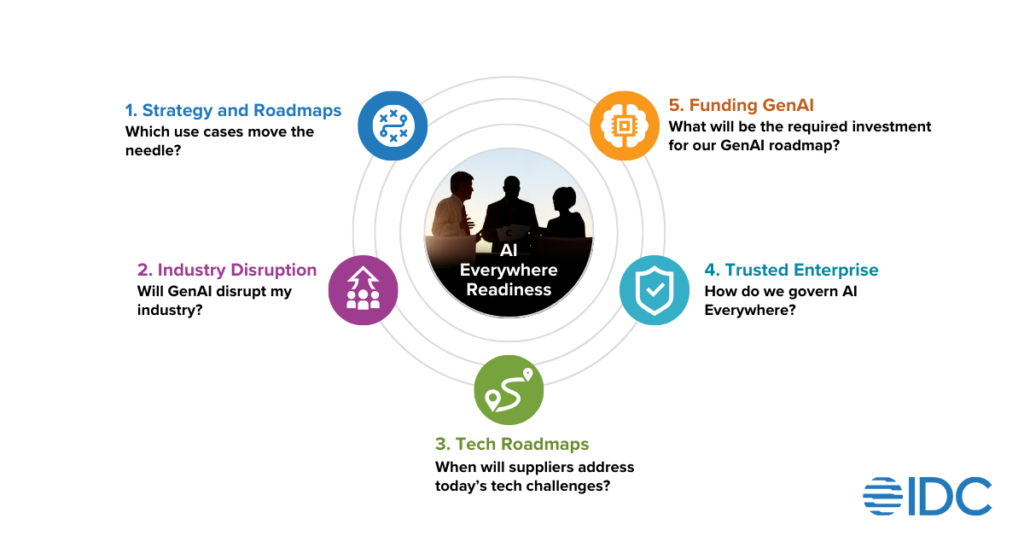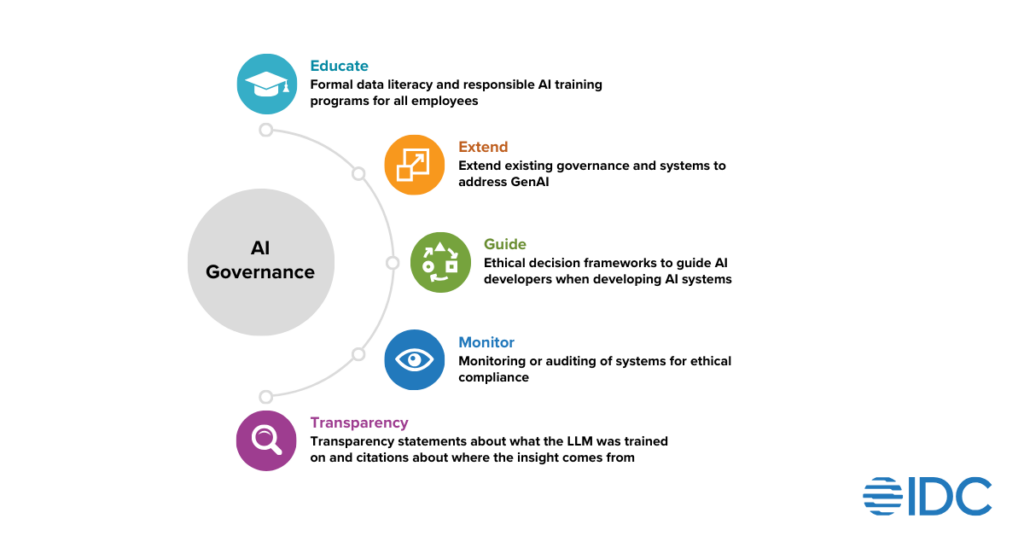The demand for GenAI is higher than we have seen with any emerging tech because it is widely recognized to impact market opportunities, competitive dynamics, and long-term strategic plans in ways we haven’t seen before.
GenAI triggers a new leg of the digital journey, one IDC refers to as AI Everywhere. In this next leg of the journey, business leaders will need to adjust their strategy, invest in new technologies, and cultivate new skills. As leaders prepare their organizations for AI Everywhere, they face the following critical decisions.

Strategy and Roadmaps
About half of organizations have an AI roadmap in place and are expected to update it to incorporate the new GenAI use cases; the rest will need to develop a roadmap with Gen AI use cases at the heart of it.
GenAI has compelling promise for both productivity gains and revenue growth. IDC predicts $1T in productivity gains by 2026 for enterprises who leverage GenAI and automation technologies and a doubling of revenue growth rates for those who use GenAI to co-develop digital products and services.
According to our global C-Suite survey, we believe organizations will prioritize productivity use cases for the next 18-24 months then revenue growth use cases in 3-5 years.
Industry Disruption
There’s no doubt GenAI has made an impact — 37% of all IT leaders worldwide believe GenAI has already disrupted their business (19%) or will significantly do so in the next 18 months (18%), according to our Global GenAI survey. Life sciences, healthcare, professional services, and media/entertainment are the industries that expect to be disrupted in the next 18 months. In life sciences and healthcare, GenAI is being used to digitize biology to reduce the time and costs to bring new drugs to market. In the media and entertainment industry, GenAI will allow broadcasters to deliver transformative viewing experiences that keep audiences engaged and entertained. And GenAI will allow IT service firms to reduce delivery costs and time, with 40% of services engagements including GenAI-enabled delivery by 2025, according to our predictions.
Tech Roadmaps
Unlike early-stage technology markets, where most organizations wait for the technology to mature, we are seeing a high percentage of organizations planning to invest early on because they recognize the competitive advantage GenAI can bring to their business. However, as tech suppliers evolve their roadmaps for GenAI, tech buyers are struggling to understand when these capabilities will be commercially available.
Enterprises are asking, “When will GenAI Security and Governance be built into the technology?”. We expect 70% of cloud and software platform providers will bundle GenAI safety and governance packages with their primary services by 2026.
They are also asking, “To what extent will cloud providers enable GenAI use cases?” We believe the answer is, “A large extent,” as cloud providers make significant investments in foundation models, AI platforms, and high-performance infrastructure. By 2025, we expect 70% of enterprises will have formed strategic ties with them for GenAI.
And in a world of distributed data, enterprise are already thinking about latency issues and when they can run LLMs on clients. We know PC OEMs, operating system vendors, and silicon providers are eager to bring inferencing capabilities down from the cloud to the client and predict that 80% of new PCs shipped for commercial use will include AI-specific silicon designed to run LLMs locally by 2027.
Maintaining Trusted Enterprise Status
Over the past several years, enterprises have worked hard to be a trusted digital business. As AI is heavily used, enterprises will need to navigate new dimensions of trust as they contend with GenAI risks around data training sets, hallucinations, security exposures and frauds. One of the biggest question enterprises are asking is, “How do we govern AI?”. To address their questions, we have developed predictions about how organizations will govern.

Educate: We believe understanding AI will be the responsibility of employees and 60% of large enterprises will mandate formal data literacy and responsible AI training to mitigate new risks created by the pervasive use of GenAI by the end of 2025.
Extend: Because GenAI has the potential to magnify existing risks around data privacy laws that govern how sensitive data is collected, used, shared, and stored, 80% of large organizations will extend their Data Loss Prevention (DLP) deployments to GenAI environments to prevent privacy violations and data breaches.
Guide: Review boards will be a critical element of the governance and by 2025, 75% G2000 companies will have implemented review boards for management oversight of ethical and responsible AI use.
Monitor: Once these oversight boards are in place, 40% of organizations will utilize AI-enabled risk and compliance solutions to continuously monitor data in real-time to predict non-compliance internally or from 3rd-party associations.
Transparency: We expect to see LLM transparency statements become the norm as over 30% of organizations that leverage sophisticated AI to produce their products or services will disclose the sources of data used to train the AI models utilized by 2026.
Funding GenAI
The demand for GenAI is high and we are forecasting that organizations will spend $16B on Gen AI in 2023, growing to $143B by 2027. But this spending will be largely dependent on the answers the IT industry provides to the questions outlined above.
- If the price for GenAI capabilities is too high, enterprises will wait until the price comes down.
- If the roadmaps are slow to address current tech challenges, enterprises will wait until they are in place.
- If trusted enterprise status cannot be maintained, enterprises will delay investments until it can be.
AI Everywhere
Rapid adoption is moving AI from an emerging software segment to a critical technology at the center of a platform transition and a new phase of computing – AI Everywhere. GenAI’s potential for innovation is comparable to the introduction of the internet and the potential is limitless. GenAI is here. Are you ready?
To learn more about AI Everywhere and what customers need now, view our GenAI resources website here.




